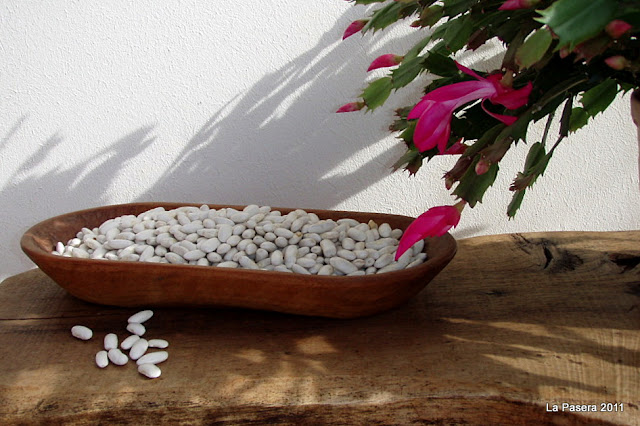Each year for the past three years we have been letting the beans, we could not eat green, carry on growing until they produce a nice fat pod filled with plump white beans. Most beans will run to seed and give you a good crop to harvest for drying. These will then be stored for eating and seed for the following season.
As the vegetable plots develop at La Pasera we are constantly adjusting what, when and how we grow our vegetables. Learning from experience and getting used to the growing conditions and weather patterns enables us to plan better and make more effective use of what we grow and eat. As eager and willing newcomers to home-produced vegetables, we have tried most things and found that certain vegetables, no matter how much we try to use, never get used whilst others we seem to never have enough of. All unused vegetables are composted but adjusting crops and seasons, we are now finding we are eating increasingly seasonally and composting less.
Beans are such useful ingredient to a whole host of dishes both hot and cold so we took the opportunity to grow more plants and harvest greater numbers of full-term beans. This year we harvested about 5kg of beans which is not a great hoard but never-the-less very welcome. We pick them when the pods are dry and become pale and papery looking. The pods are left to dry for a few days in the sun then the beans shelled and dried thoroughly over the following few weeks. Once dried, the bean are popped in the freezer for 24 hours to ensure any bugs or parasites are killed. Defrosted, dried once again and stored, the beans will keep until needed.
Beans are a fairly easy and rewarding crop with few pests and diseases attacking them. We initially have to protect then against slug and snails attacks using one of several organic methods including organic slug pellets, coffee grounds, ash and egg shells, until the plants reach a certain size after which they can withstand further attacks. We also find that some bean plants are prone to black fly attacks for which we use a soapy water spray every two weeks as this keeps them at bay.
Around the village seeing bunches of beans drying on a balcony balustrade or against a dry wall is a common sight. At the moment, we don't produce enough to do this but given time.....
As the vegetable plots develop at La Pasera we are constantly adjusting what, when and how we grow our vegetables. Learning from experience and getting used to the growing conditions and weather patterns enables us to plan better and make more effective use of what we grow and eat. As eager and willing newcomers to home-produced vegetables, we have tried most things and found that certain vegetables, no matter how much we try to use, never get used whilst others we seem to never have enough of. All unused vegetables are composted but adjusting crops and seasons, we are now finding we are eating increasingly seasonally and composting less.
Beans are such useful ingredient to a whole host of dishes both hot and cold so we took the opportunity to grow more plants and harvest greater numbers of full-term beans. This year we harvested about 5kg of beans which is not a great hoard but never-the-less very welcome. We pick them when the pods are dry and become pale and papery looking. The pods are left to dry for a few days in the sun then the beans shelled and dried thoroughly over the following few weeks. Once dried, the bean are popped in the freezer for 24 hours to ensure any bugs or parasites are killed. Defrosted, dried once again and stored, the beans will keep until needed.
Beans are a fairly easy and rewarding crop with few pests and diseases attacking them. We initially have to protect then against slug and snails attacks using one of several organic methods including organic slug pellets, coffee grounds, ash and egg shells, until the plants reach a certain size after which they can withstand further attacks. We also find that some bean plants are prone to black fly attacks for which we use a soapy water spray every two weeks as this keeps them at bay.



I used to grow "Brown Dutch" beans for drying, they are a short variety. Lovely for soups or savouries.
ReplyDeleteI'd like to find a reliable white seeded variety for drying